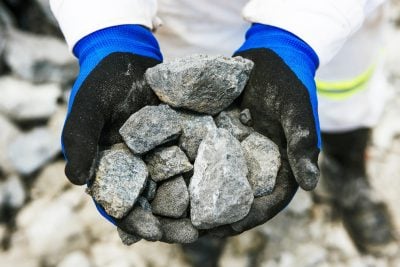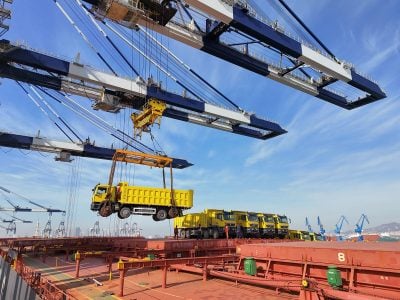Located in the undulating hills south of the Suikerbosrand mountain reserve near Johannesburg, Karan Beef’s vast cattle facility is the largest of its kind in a country where red-meat consumption is a way of life.
At the 2,330 hectare Heidelberg estate, young calves between seven and 12 months are purchased from breeders, placed in pens of up to 120 animals, and weaned on starter rations and feed from an on-site mill capable of producing up to 1,740 tons per day.
Some 150,000 head of cattle at any one time are fed and watered in this system, bulking them up for the short final journey to the Karan-owned abattoir at nearby Balfour, where their carcasses are processed and dispatched to freezer storage in Johannesburg for onwards sale.
Emerging from humble origins – Karan’s herd totalled less than 100 in 1974 – the firm has expanded to become a fully integrated operation attracting major investment.
In 2018, South Africa’s state-owned Public Investment Corporation and Pelo Agricultural Ventures, a black economic empowerment group, agreed to pay up to $365m for a majority stake in the company.
Previously content to wean cattle for local enthusiasts of the braai – the red-meat dominated South African barbecue – producers like Karan Beef now lead a red meat industry with some R70bn ($4.9bn) a year in turnover and huge export potential.
“You will find that we are very competitive on the commercial side in terms of beef production,” says Gerhard Schutte, chief executive of South Africa’s Red Meat Producers Organisation.
“About 80% of all our beef is finished up in feedlots. Our industry is quite young compared to the Australian and US feedlot industry.
“We are quite high tech because we started later and could implement what we learned on an international basis.”
That embrace of technology is helping South African producers respond to a huge increase in demand for meat across Africa that is expected to stretch well into the future.
With Africa’s population projected to more than double by the middle of the century to 2.5bn and GDP per capita on the continent expected to continue rising, meat consumption will become affordable to millions of Africans for the first time.
The United Nations Food and Agriculture Organisation (FAO) estimates that the consumption of beef on the continent will increase 200% between 2015 and 2050, while poultry consumption will grow by 211% and pork by 200%.
Opportunities for investment are likely to prove more attractive in Africa than other global regions, according to the organisation, with future investments required across the value chain in poultry and pork facilities, abattoirs, feed production, transport and equipment supply.
And yet despite the huge potential of the meat market, the rapid increase in demand poses a series of challenges for Africa’s relatively young and underdeveloped industry.
While industrial-scale producers like Karan offer a compelling vision of the future, the majority of African livestock are raised in very different conditions, often in inefficient, unproductive smallholder environments isolated from markets and abattoirs by limited infrastructure.
Weaned on ineffective feed and with poor disease resistance and limited veterinary care, many animals fail to yield their true economic or nutritious value.
Meanwhile, the increasing global awareness of the environmental costs of meat production – particularly by methane emitting cattle and other ruminants – raises the question of whether large-scale livestock farming poses risks for Africa.
Given these challenges, Africa will struggle to satisfy its bulging appetite for meat without resorting to expensive imports, according to experts.
“I think it can be said that demand for animal sourced foods will increase considerably over the coming decades driven by population growth, urbanisation and increasing incomes,” says Jimmy Smith, director general of the Nairobi-based International Livestock Research Institute (ILRI).
“The question is whether that is going to be met by importation.
“If you look at the projections, Africa’s food bill will be about $125bn by 2025/30. A third of that [comprised of animal-sourced foods] is going to be a huge bill with tremendous opportunity costs.”
For Africa’s policymakers, the question will be how to nurture a shift to more efficient modes of production to meet demand and encourage exports while protecting the environment and improving the lot of smallholder farmers.
Industrial or pastoral?
For centuries, Fulani nomadic herdsmen have driven their cattle across the plains of Nigeria, seeking out traditional watering holes and pastures across the country’s north.
Approximately 99% of Nigeria’s cattle are managed traditionally, according to Fitch Solutions, principally by herders using generations of expertise to eke advantage out of tough landscapes and limited resources.
Yet in recent years, herders have faced a series of critical challenges that permanently threaten their way of life.
Climate change-induced desertification, urbanisation, land encroachment and the Boko Haram insurgency have forced herders south of their traditional grazing grounds.
Here, they are forced to compete for land with settled Christian farmers, sparking deadly clashes estimated to have taken 2,500 lives in 2016 alone.
These challenges, combined with the historic limitations of nomadic farming – long transit times, theft, limited technology and productivity – have long held back Nigeria’s potential as a major beef producer.
According to Fitch, consumer demand for beef will exceed 450,000 tonnes in 2023, but the domestic industry will only be capable of delivering some 370,000 tonnes.
When compared to South Africa – which already produces over 1,000,000 tonnes a year and is expected to consistently remain above that in the years ahead, it seems clear that Nigerian pastoralism has its limits.
And yet experts argue that even a system as apparently unproductive as nomadic herding could play a rejuvenated part in the continent’s livestock industry, given the right support.
“We have to recognise that pastoral systems are there; they are low input, low output, but the land they inhabit is harsh and cannot be used for anything else,” says Jimmy Smith.
“We need to better map these areas, preserve the pastoral system better, and provide support to them in the context of marketing, rural services and water.
“If some investment is made in basic needs, I’m sure they can be made more productive.”
While parts of South Africa’s industry are a case study in the successful implementation of an intensive industry, there is a growing awareness that an industrialised model of agricultural may not be appropriate for other African states, many of whom, like Nigeria, do not have substantial commercial livestock sectors.
In Tanzania, commercial enterprises – registered companies with a certain number of permanent wage employees – contributed just 5.1% of beef production in 2014.
Instead, many African countries rely on herders or smallholder farmers.
Data from seven sub-Saharan African countries in 2014 showed that almost two-thirds of rural households keep livestock, with percentages ranging from 44% in Nigeria to 79% in Niger.
In Tanzania, households are estimated to keep over 95% of the country’s cattle and poultry.
In South Africa, where the commercial industry accounts for around 60% of the market, household owners largely struggle to be competitive.
Gerhard Schutte cites census data revealing that some 1.2m domestic households in the country own livestock, but argues that they are held back by a lack of property rights, fencing, and limited anti-disease programmes.
Instead of emulating industrialised agricultural systems, policymakers in some countries should prioritise raising the status of smallholder farmers and herders and the productivity of their animals, says Jimmy Smith.
“We argue that the best opportunity to respond is to transform the millions and millions of smallholders who are already the biggest suppliers – they supply more than 70% of animal-sourced foods consumed in Africa.
“If one were able to connect those farmers to markets through improved infrastructure or new milk-collecting facilities, local abattoirs – those kinds of things can help these farmers.
“A little bit of investment in extension services and rural roads is low hanging fruit.”
And yet in too many countries, governments fail to provide even limited support for livestock smallholders, preventing them from ascending the value chain and growing into viable businesses.
In 2003, African heads of state and government endorsed the Maputo Declaration, where they agreed to a “commitment to the allocation of at least 10% of national budgetary resources to agriculture and rural development policy implementation within five years.”
Sixteen years later, less than 10 countries are complying, according to experts.
“If the public services do not work well you’re not going to have good extension services for livestock farmers, you will have difficulties with infrastructure and electricity.
The overarching conditions won’t be there for large livestock farms to be really successful in Africa… I don’t see a radical transformation in the livestock sector in Africa over the next 30 years,” says Ugo Pica-Ciamarra, livestock economist at the FAO.
According to the FAO, a successful investment strategy to benefit smallholders would involve identifying those smallholders that are business-oriented and have incentives to expand their production and tap into the livestock products market.
Depending on the country, between 5% and 21% of livestock-keeping households are anticipated to have such incentives.
An integrated pan-African strategy would accept that not all smallholders can become surplus producers and target investments accordingly, says Pica-Ciamarra. That is yet to happen, he argues.
“I would say the conversation is always there but from my experience I don’t think right now there are really major pan-African investments targeting the livestock sector or how to increase productivity.
“We have examples from here and there led by international organisations, but in general I don’t think there’s really a lot – it’s more private sector investment.”
Enter the private sector
Where governments have failed to invest, the private sector is stepping up.
Given the immense opportunities of the continent’s swelling dietary needs, local and foreign agriculture investors are showing their interest.
Once dominated by ruminants including cattle, goats and sheep, the private sector is gradually moving African agriculture towards the cost-efficient intensive farming of chicken and pigs.
Africa’s poultry population is expected to increase by 241% by 2050, while the number of pigs is expected to increase by 184%.
By contrast, the cattle population is expected to grow by 111% and the sheep population by 92%.
“The projections say that Africa will be increasingly self-sufficient in milk and poultry.
“Right now perhaps 35% of milk and poultry are imported, and in the future it will be 20% or less.
“This is not really the case for beef because there are water and land constraints,” says Pica-Ciamarra.
Schutte believes that consumption patterns on the continent will gradually change, with long-favoured beef and sheep meat coming to be regarded as high-end consumer products compared to factory-farmed chicken and pork.
Only in beef will Africa’s percentage of consumption from imports increase, according to data from the FAO, which projects that the continent will become more sufficient in pigmeat, poultry, milk and eggs as investment increases.
Those sectors are likely to be at the heart of the continent’s renewed private sector push, but there will also be significant opportunities for the private sector in ancillary services, according to Jimmy Smith.
‘There is a tremendous role for big business. The transformation will require investments in milk processing, abattoirs, other kinds of processing plants for the offtake of products, input supply.
So that’s not a small farmer activity, this is where the private sector has been very prominent in other parts of the world. It will require better veterinary services, drugs, vaccines, feed supplies to smallholders.”
Environmental challenges
And yet the gradual introduction of intensive factory farming, alongside the expected vast increase in methane-emitting cattle from expanding traditional industries, is likely to raise significant environmental concerns for a continent on the frontline in the battle against climate change.
An influential 2018 report led by Marco Springmann of Oxford University and compiled by 23 global researchers concluded that a huge reduction in meat-eating is essential to avoid climate change, and that enormous changes are needed to global farming practices to avert its worst effects.
Without concerted action, the environmental impacts of the food system could increase by 50-90% by 2050 as a result of population growth and the rise of diets high in fats, sugars and meat, says the research.
Furthermore, climate change could lead to the destruction of pasture and water supply, threatening the resurgent African agricultural industry itself.
Rising temperatures bring the risk of tropical livestock diseases in previously low-risk areas.
“Feeding a world population of 10bn is possible, but only if we change the way we eat and the way we produce food,” Professor Johan Rockström at the Potsdam Institute for Climate Impact Research in Germany, who was part of the research team, told the Guardian newspaper of London.
“Greening the food sector or eating up our planet: this is what is on the menu today.”
Just as concerning as emissions are a range of local environmental factors, including water and soil pollution and the potential for new human diseases emanating from the increased proximity of large numbers of livestock, says Pica-Ciamarra.
“There are a number of issues [policymakers] should look at otherwise there’s a serious risk to natural resources used by Africans.”
Tackling the low productivity of Africa’s animals – whether smallholder or commercial – is critical to mitigating emissions and other environmental dangers, says ILRI’s Jimmy Smith.
Beef and veal output per head of cattle in North America is around 281kg, while yields in Africa are around 142kg.
“Emissions per unit of product are higher in Africa than in America or Europe, and that’s because the productivity of the animals is low.
“If that cow which in Africa produces 2 litres of milk is made to give 5-10 litres, the emissions per unit of product goes down.
“If we can improve that, we can get the amount of output from animals that we want and don’t have to add more animals, which is what we do now.”
Central to this effort to boost productivity and mitigate the environmental impact of animals is the adoption of new technology.
While feedlots such as Karan have driven down inefficiencies in the South African beef industry, the ILRI is pioneering new schemes to breed and introduce higher-yielding, disease-resistant chickens to smallholder farmers.
The South African beef industry hopes to introduce a traceability system to help isolate future outbreaks of foot and mouth disease after an outbreak this year led neighbouring countries to place temporary bans on South African meat.
New breeding techniques, combined with the use of indigenous animals well suited to local climates, can vastly improve productivity and cut down on wastage.
“In many parts of the developing world most poultry still comes from indigenous systems – these are low input, low output, and can be improved technologically, says Smith.
“Indigenous systems can be made much more productive at relatively low cost… these things can be done with relatively small amounts of money and can be done across the whole continent.”
Such careful adaptation to local surroundings, combined with the rigorous application of appropriate technology, works as well in the commercial sector as it does in the smallholder world, according to Schutte.
“We’ve got indigenous species we think are very adapted towards these [environmental] changes – they [farmers]will have to make shifts towards more adaptable animals and I think it’s possible.”
Rather than choosing between commercial and smallholder models – both of which will continue to play a crucial and complementary role in Africa’s livestock future – policymakers should consider appropriate investment and technological support to both sectors in a bid to boost productivity and mitigate environmental damage across the board, says Smith.
Without new efforts, the continent could squander the multi-billion dollar opportunity of millions of new African meat-eaters in favour of a vast importation bill and the possibility of unconstrained environmental damage.
“As ministers of finance see more and more the importation bill, they will be inclined to invest in the sector, so I’m hopeful that there will be a greater response to the opportunities that exist.
“I’m not happy with the current response, but hopefully it will change over time.”
Want to continue reading? Subscribe today.
You've read all your free articles for this month! Subscribe now to enjoy full access to our content.
Digital Monthly
£8.00 / month
Receive full unlimited access to our articles, opinions, podcasts and more.
Digital Yearly
£70.00 / year
Our best value offer - save £26 and gain access to all of our digital content for an entire year!
 Sign in with Google
Sign in with Google 



